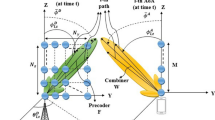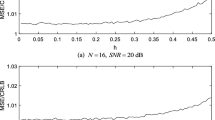Abstract
Under the condition of strong clutter and finite training samples, a novel CFAR detector based on the proposed adaptive pulse compression-Capon filter (APC-Capon filter) is presented for MIMO array radar which transmits intrapulse coded waveforms. Both theoretical analysis and numerical simulations show that the proposed APC-Capon filter can utilize the non-reiterative adaptive pulse compression technique to alleviate both range sidelobes and mutual interference; at the same time it also can borrows ideas from the coherent signals cancellation of adaptive beamforming to perform clutter suppression. The detection performance simulations show that, with the same size parameters (including code length and the numbers of transmitter elements, receiver elements as well as pulses), the proposed CFAR detector is inferior to the adaptive matched filter (AMF) detector. But as the size parameters increase, the proposed CFAR detector will gradually outperform the AMF detector with smaller size parameters, and more importantly, unlike the AMF detector which has a lot of difficulties in performing due to the inordinate demands for the computational complexity and training sample size, this demands of the proposed CFAR detector will not significantly increase. The simulations also show that, the correlation properties of these intrapulse coded waveforms have certain effect on the APC-Capon filter and its corresponding CFAR detector. But fortunately, the effect will decrease as the number of intrapulse coded waveforms increases.
Similar content being viewed by others
References
Chen C Y, Vaidyanathan P P. MIMO radar space-time adaptive processing using prolate spheroidal wave functions. IEEE Trans Signal Process, 2008, 56: 623–635
Blunt S D, Gerlach K. Adaptive pulse compression via MMSE estimation. IEEE Trans Aerospace Electron Syst, 2006, 42: 572–584
Blunt S D, Gerlach K. Multistatic adaptive pulse compression. IEEE Trans Aerospace Electron Syst, 2006, 42: 891–903
Zhang J D, Wang H Q, Zhu X H, et al. Adaptive pulse compression via MSN criteria. J Electron AAA Inf Technol, 2009, 31: 790–793
Li N, Tang J, Peng Y N. Adaptive pulse compression of MIMO radar based on GSC. Electron Lett, 2008, 44: 1–2
Wang J, Jiang S, He J, et al. Adaptive detectors with diagonal loading for airborne multi-input multi-output radar. IET Radar Sonar Navigation, 2009, 3: 493–501
Wang Y L, Peng Y N. Space-Time Adaptive Processing. Beijing: Tsinghua University Press, 2000. 26–67
Shan T J, Kailath T. Adaptive beamforming for coherent signals and interference. IEEE Trans Acoustics Speech Signal Process, 1985, 33: 527–536
Guan J, Peng Y N, He Y. Proof of CFAR by the use of the invariant test. IEEE Trans Aerospace Electron Syst, 2000, 36: 336–339
Kay S M. Fundamentals of Statistical Signal Processing Volume I, and II: Estimation Theory and Detection Theory (in Chinese). Beijin: Publishing House of Electronics Industry, 2006. 411–413
Author information
Authors and Affiliations
Corresponding author
Rights and permissions
About this article
Cite this article
Guan, J., Huang, Y. & He, Y. A CFAR detector for MIMO array radar based on adaptive pulse compression-Capon filter. Sci. China Inf. Sci. 54, 2411–2424 (2011). https://doi.org/10.1007/s11432-011-4329-1
Received:
Accepted:
Published:
Issue Date:
DOI: https://doi.org/10.1007/s11432-011-4329-1




